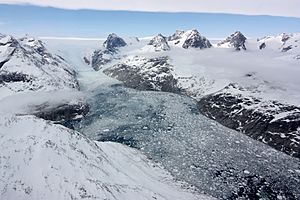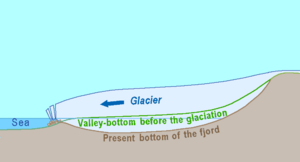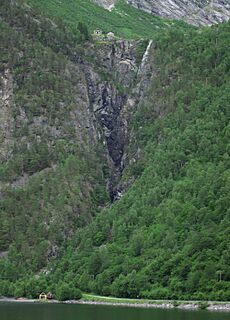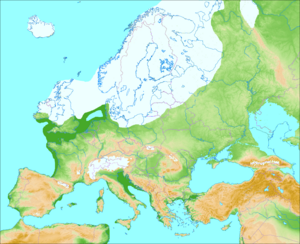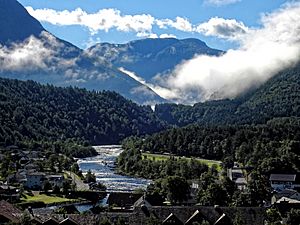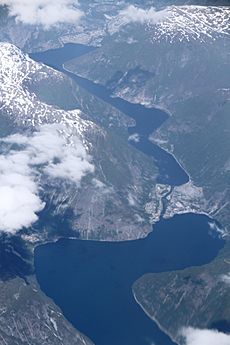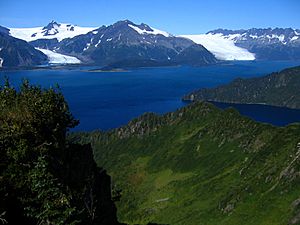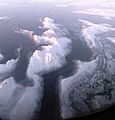Fjord facts for kids
A fjord (pronounced "fyord") is a long, narrow arm of the sea. It has very steep sides or cliffs. Fjords are created by powerful glaciers. You can find them in cold places like Antarctica, the Arctic, and along the coasts of many northern and southern countries. For example, Norway has nearly 1,200 fjords, making its coastline seem much longer than it actually is!
Contents
How Fjords are Formed
Fjords are amazing natural wonders carved by glaciers. Imagine a giant river of ice slowly moving through a valley. As the glacier moves, it scrapes and grinds away the rock beneath it. This process creates a deep, U-shaped valley.
Glaciers Carve Valleys
Over thousands of years, the glacier digs deeper and deeper. It uses its immense weight and the rocks frozen within it to erode the land. When the ice melts, the sea floods these deep valleys, creating a fjord. Many fjords are much deeper than the nearby ocean. For instance, Sognefjord in Norway goes down about 1,300 meters (4,265 feet) below sea level!
At the mouth of a fjord, there's often a shallower area called a "sill." This sill is made of bedrock or rocks left behind by the glacier. It's like a natural underwater barrier. Sometimes, these sills cause very strong currents and rapids when the tides change.
Land Bounces Back
After the heavy glaciers melt, the Earth's crust slowly rises back up. This is because the enormous weight of the ice is gone. This process is called "glacial rebound." Sometimes, the land rises faster than the sea level, which can turn parts of old fjords into freshwater lakes.
Hanging Valleys and Waterfalls
You'll often see "hanging valleys" along fjords. These are smaller valleys that sit high above the main fjord. They were carved by smaller glaciers that joined the main, larger glacier. Because the main glacier carved much deeper, the smaller valleys were left "hanging" high up. Often, beautiful waterfalls tumble from these hanging valleys into the fjord below. These waterfalls are also a source of fresh drinking water.
Amazing Fjord Features
Fjords are not just beautiful; they are also home to unique environments and wildlife.
Water in the Fjord
The water in fjords is a mix of fresh river water and salty ocean water. In winter, the surface water cools and mixes with deeper water. Strong winds can pull salty water from the coast into the fjord's depths.
In summer, lots of fresh river water flows in. This creates a layer of less dense, brackish (slightly salty) water on top. This top layer flows out towards the ocean. Underneath, a reverse current of saltier water flows in from the coast. In some fjords, especially those with shallow sills, the deep water doesn't mix well. This can lead to low oxygen levels, making it hard for fish and other animals to live there.
Hidden Coral Reefs
Did you know there are coral reefs deep inside some fjords? In 2000, scientists found coral reefs along the bottom of Norwegian fjords. These reefs are like underwater cities, supporting thousands of creatures. They are home to plankton, corals, anemones, fish, and even sharks! These animals are specially adapted to live in the dark, high-pressure environment of the deep sea.
In New Zealand's fjords, a layer of dark freshwater on the surface allows deep-water corals to grow in shallower areas than usual. You can even see them from an underwater observatory in Milford Sound without needing to dive!
Skerries: Island Shields
Near the sea, where fjords meet the open ocean, you might find "skerries." These are thousands of small, rocky islands and reefs. The word "skerry" comes from an old Norse word meaning "rock in the sea."
Skerries form where glaciers carved many channels in different directions. They create a natural shield, protecting the coast. For example, along the coast of Norway, skerries form a long, protected waterway. You can travel almost the entire 1,601 kilometers (995 miles) from Stavanger to North Cape through this sheltered passage!
Tiny Ocean Plants: Phytoplankton
Fjords are special places for tiny ocean plants called phytoplankton. These microscopic organisms are the base of the ocean's food web. In polar fjords, melting glaciers bring cold, fresh water and nutrients. These nutrients help phytoplankton grow, especially diatoms. This makes these fjords important feeding grounds for many other species.
However, the sediment carried by glaciers can make the water cloudy. This reduces sunlight deeper in the fjord, which can limit where phytoplankton can grow. Scientists are actively studying phytoplankton in fjords, even with the help of citizen science projects like FjordPhyto!
Special Epishelf Lakes
An "epishelf lake" is a unique type of lake found in some fjords. It forms when meltwater gets trapped behind a floating ice shelf. This freshwater floats on top of the denser saltwater below. The surface of an epishelf lake can even freeze, creating a completely isolated ecosystem.
The Word "Fjord"
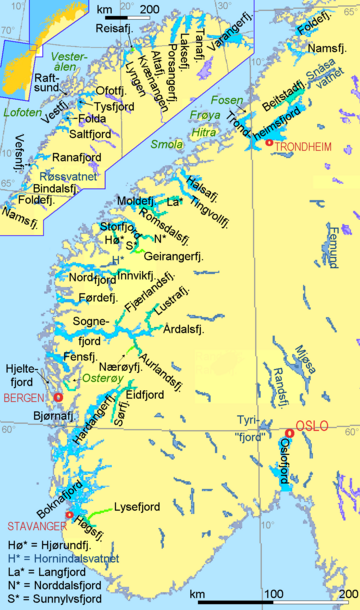
The word "fjord" comes from the Norwegian word fjord. In Norway, this word has a broader meaning. It can refer to any long, narrow body of water, not just those carved by glaciers. For example, the Oslofjord is called a fjord in Norway, even though it's a different type of geological feature.
The Norwegian word comes from Old Norse fjǫrðr, which meant a 'lake-like' body of water used for travel. It's related to words like "fare" and "ferry" in English, which also have to do with traveling.
In Scandinavian countries like Norway, Denmark, and Sweden, the word "fjord" is used more generally than in English. It can describe narrow sea inlets, long freshwater lakes (like Randsfjorden and Tyrifjorden in Norway), and even some rivers. In Sweden, a similar word, fjärd, is used for bays and inlets along the Baltic Sea coast.
Not All Inlets are Fjords
Sometimes, other types of inlets are mistakenly called fjords. However, a true fjord, in the scientific sense, must be carved by a glacier.
Inlets Mistaken for Fjords
Many beautiful, steep-sided inlets around the world are often called "fjords" by locals or in tourist guides, but they were not formed by glaciers. These are usually "rias," which are drowned river valleys flooded by the sea.
For example:
- The Lim bay in Croatia is often called "Lim fjord," but it's actually a ria formed by a river.
- The Bay of Kotor in Montenegro is another example of a ria, not a glacial fjord.
- Milford Haven Waterway in Wales is also a ria, even though its name comes from an Old Norse word meaning "sandbank fjord."
Freshwater Fjords
Some freshwater lakes in Norway and other glaciated regions are also called fjords. These lakes formed in long, glacially carved valleys, just like sea fjords. However, their outlets were blocked by natural dams, such as piles of glacial debris or land that rose after the ice melted.
For example, Tyrifjorden in Norway is a large freshwater lake. Parts of it are actually below sea level, even though the lake's surface is 63 meters (207 feet) above sea level! Norway's largest lake, Mjøsa, is also sometimes called "the fjord" by people living nearby.
After the last ice age, some areas of land were much lower. The ocean filled many valleys, creating saltwater fjords. As the land slowly rose due to glacial rebound, these areas were cut off from the sea, turning them into freshwater lakes. For instance, Heddalsvatnet in Norway was a saltwater fjord until about 1500 BC, when the rising land separated it from the ocean.
Outside of Norway, New Zealand's Lake Te Anau has three western arms called North Fiord, Middle Fiord, and South Fiord. Another freshwater "fjord" is Western Brook Pond in Newfoundland's Gros Morne National Park. These are often called "fjord lakes" because they were formed by glaciers but are now filled with fresh water.
Where to Find Fjords
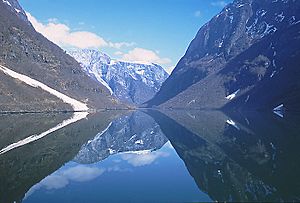

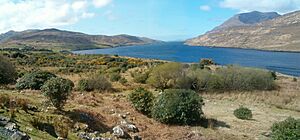
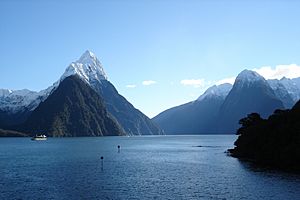
Fjords are found in mountainous areas where glaciers once reached the sea. These places usually have strong winds that bring lots of snow, feeding the glaciers.
Main Fjord Regions
Some of the most famous fjord regions include:
- The west coast of Norway (including Svalbard)
- The Westfjords and Eastern Region of Iceland
- The west coast of North America, from Puget Sound to Alaska
- The southwest coast of New Zealand (called Fiordland)
- The west and southwest coasts of South America, especially in Chile
- Greenland and the Canadian Arctic Archipelago
Other Fjord Areas
You can also find fjords, or similar features, in other places like:
- Ireland (e.g., Killary Harbour)
- Scotland (where they are called firths or sea lochs, like Loch Fyne)
- Parts of Russia (e.g., Kola Peninsula)
- The Saguenay River in Quebec, Canada
- Somes Sound in Acadia National Park, Maine, USA
- South Georgia and Kerguelen Islands in the sub-Antarctic
Longest and Deepest Fjords
Some fjords are incredibly long or deep:
- The longest fjords include Nansen Sound/Greely Fiord/Tanquary Fiord in Canada (420 km or 261 mi) and Scoresby Sund in Greenland (382 km or 237 mi).
- Norway's Sognefjord is 226 km (140 mi) long.
- The deepest fjords are Skelton Inlet in Antarctica (1,933 m or 6,342 ft deep) and Sognefjord in Norway (1,308 m or 4,291 ft deep).
Special Heritage Fjords
Norway has several "heritage fjords" that are protected, including UNESCO World Heritage Sites. To help protect these beautiful places, visiting ships were required to be low-emission by 2026 and will be zero-emission by 2032. Some of these include:
- Geirangerfjord
- Nærøyfjord
- Hardangerfjord
- Trollfjord
Images for kids
-
The entrance to Larsen Harbour, part of Drygalski Fjord in South Georgia Island.
-
The end of Inostrantsev Glacier at Inostrantsev Fjord, Novaya Zemlya.
See also
 In Spanish: Fiordo para niños
In Spanish: Fiordo para niños
- Firth
- Ria



